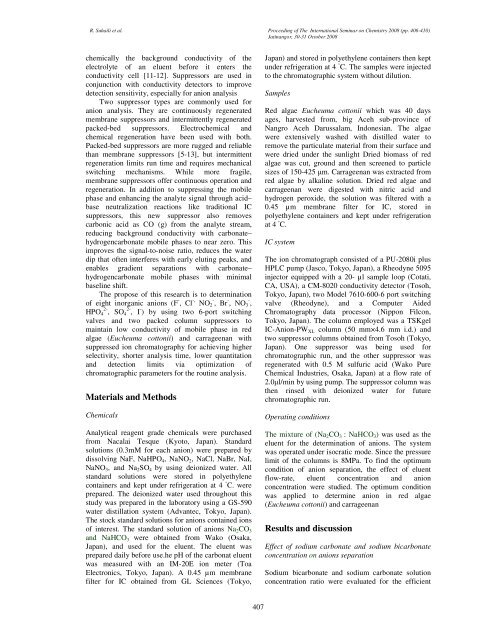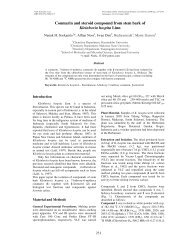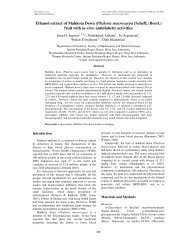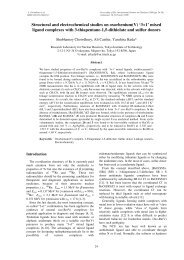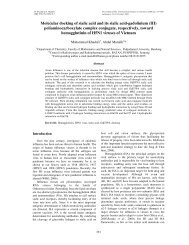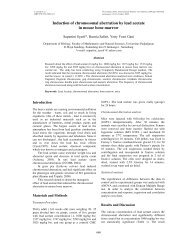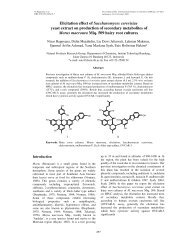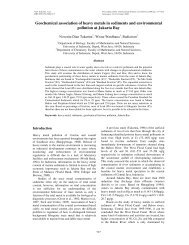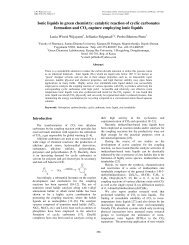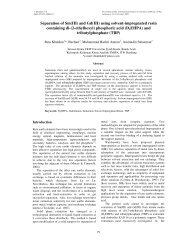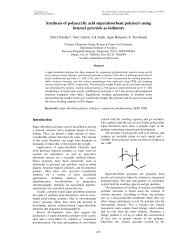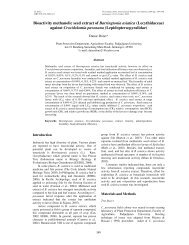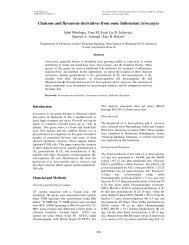Determination of inorganic anions in red algae (Eucheuma cottonii ...
Determination of inorganic anions in red algae (Eucheuma cottonii ...
Determination of inorganic anions in red algae (Eucheuma cottonii ...
- No tags were found...
You also want an ePaper? Increase the reach of your titles
YUMPU automatically turns print PDFs into web optimized ePapers that Google loves.
R. Suhaili et al. Proceed<strong>in</strong>g <strong>of</strong> The International Sem<strong>in</strong>ar on Chemistry 2008 (pp. 406-410)Jat<strong>in</strong>angor, 30-31 October 2008chemically the background conductivity <strong>of</strong> theelectrolyte <strong>of</strong> an eluent before it enters theconductivity cell [11-12]. Suppressors are used <strong>in</strong>conjunction with conductivity detectors to improvedetection sensitivity, especially for anion analysisTwo suppressor types are commonly used foranion analysis. They are cont<strong>in</strong>uously regeneratedmembrane suppressors and <strong>in</strong>termittently regeneratedpacked-bed suppressors. Electrochemical andchemical regeneration have been used with both.Packed-bed suppressors are more rugged and reliablethan membrane suppressors [5-13], but <strong>in</strong>termittentregeneration limits run time and requires mechanicalswitch<strong>in</strong>g mechanisms. While more fragile,membrane suppressors <strong>of</strong>fer cont<strong>in</strong>uous operation andregeneration. In addition to suppress<strong>in</strong>g the mobilephase and enhanc<strong>in</strong>g the analyte signal through acid–base neutralization reactions like traditional ICsuppressors, this new suppressor also removescarbonic acid as CO (g) from the analyte stream,<strong>red</strong>uc<strong>in</strong>g background conductivity with carbonate–hydrogencarbonate mobile phases to near zero. Thisimproves the signal-to-noise ratio, <strong>red</strong>uces the waterdip that <strong>of</strong>ten <strong>in</strong>terferes with early elut<strong>in</strong>g peaks, andenables gradient separations with carbonate–hydrogencarbonate mobile phases with m<strong>in</strong>imalbasel<strong>in</strong>e shift.The propose <strong>of</strong> this research is to determ<strong>in</strong>ation<strong>of</strong> eight <strong><strong>in</strong>organic</strong> <strong>anions</strong> (F - , Cl -, NO 2 - , Br - , NO 3 - ,HPO 4 2- , SO 4 2- , I - ) by us<strong>in</strong>g two 6-port switch<strong>in</strong>gvalves and two packed column suppressors toma<strong>in</strong>ta<strong>in</strong> low conductivity <strong>of</strong> mobile phase <strong>in</strong> <strong>red</strong><strong>algae</strong> (<strong>Eucheuma</strong> <strong>cottonii</strong>) and carrageenan withsuppressed ion chromatography for achiev<strong>in</strong>g higherselectivity, shorter analysis time, lower quantitationand detection limits via optimization <strong>of</strong>chromatographic parameters for the rout<strong>in</strong>e analysis.Materials and MethodsChemicalsAnalytical reagent grade chemicals were purchasedfrom Nacalai Tesque (Kyoto, Japan). Standardsolutions (0.3mM for each anion) were prepa<strong>red</strong> bydissolv<strong>in</strong>g NaF, NaHPO 4 , NaNO 2 , NaCl, NaBr, NaI,NaNO 3 , and Na 2 SO 4 by us<strong>in</strong>g deionized water. Allstandard solutions were sto<strong>red</strong> <strong>in</strong> polyethyleneconta<strong>in</strong>ers and kept under refrigeration at 4 ◦ C. wereprepa<strong>red</strong>. The deionized water used throughout thisstudy was prepa<strong>red</strong> <strong>in</strong> the laboratory us<strong>in</strong>g a GS-590water distillation system (Advantec, Tokyo, Japan).The stock standard solutions for <strong>anions</strong> conta<strong>in</strong>ed ions<strong>of</strong> <strong>in</strong>terest. The standard solution <strong>of</strong> <strong>anions</strong> Na 2 CO 3and NaHCO 3 were obta<strong>in</strong>ed from Wako (Osaka,Japan), and used for the eluent. The eluent wasprepa<strong>red</strong> daily before use.he pH <strong>of</strong> the carbonat eluentwas measu<strong>red</strong> with an IM-20E ion meter (ToaElectronics, Tokyo, Japan). A 0.45 µm membranefilter for IC obta<strong>in</strong>ed from GL Sciences (Tokyo,Japan) and sto<strong>red</strong> <strong>in</strong> polyethylene conta<strong>in</strong>ers then keptunder refrigeration at 4 ◦ C. The samples were <strong>in</strong>jectedto the chromatographic system without dilution.SamplesRed <strong>algae</strong> <strong>Eucheuma</strong> <strong>cottonii</strong> which was 40 daysages, harvested from, big Aceh sub-prov<strong>in</strong>ce <strong>of</strong>Nangro Aceh Darussalam, Indonesian. The <strong>algae</strong>were extensively washed with distilled water toremove the particulate material from their surface andwere dried under the sunlight Dried biomass <strong>of</strong> <strong>red</strong><strong>algae</strong> was cut, ground and then screened to particlesizes <strong>of</strong> 150-425 µm. Carrageenan was extracted from<strong>red</strong> <strong>algae</strong> by alkal<strong>in</strong>e solution. Dried <strong>red</strong> <strong>algae</strong> andcarrageenan were digested with nitric acid andhydrogen peroxide, the solution was filte<strong>red</strong> with a0.45 µm membrane filter for IC, sto<strong>red</strong> <strong>in</strong>polyethylene conta<strong>in</strong>ers and kept under refrigerationat 4 ◦ C.IC systemThe ion chromatograph consisted <strong>of</strong> a PU-2080i plusHPLC pump (Jasco, Tokyo, Japan), a Rheodyne 5095<strong>in</strong>jector equipped with a 20- µl sample loop (Cotati,CA, USA), a CM-8020 conductivity detector (Tosoh,Tokyo, Japan), two Model 7610-600-6 port switch<strong>in</strong>gvalve (Rheodyne), and a Computer AidedChromatography data processor (Nippon Filcon,Tokyo, Japan). The column employed was a TSKgelIC-Anion-PW XL column (50 mm×4.6 mm i.d.) andtwo suppressor columns obta<strong>in</strong>ed from Tosoh (Tokyo,Japan). One suppressor was be<strong>in</strong>g used forchromatographic run, and the other suppressor wasregenerated with 0.5 M sulfuric acid (Wako PureChemical Industries, Osaka, Japan) at a flow rate <strong>of</strong>2.0µl/m<strong>in</strong> by us<strong>in</strong>g pump. The suppressor column wasthen r<strong>in</strong>sed with deionized water for futurechromatographic run.Operat<strong>in</strong>g conditionsThe mixture <strong>of</strong> (Na 2 CO 3 : NaHCO 3 ) was used as theeluent for the determ<strong>in</strong>ation <strong>of</strong> <strong>anions</strong>. The systemwas operated under isocratic mode. S<strong>in</strong>ce the pressurelimit <strong>of</strong> the columns is 8MPa. To f<strong>in</strong>d the optimumcondition <strong>of</strong> anion separation, the effect <strong>of</strong> eluentflow-rate, eluent concentration and anionconcentration were studied. The optimum conditionwas applied to determ<strong>in</strong>e anion <strong>in</strong> <strong>red</strong> <strong>algae</strong>(<strong>Eucheuma</strong> <strong>cottonii</strong>) and carrageenanResults and discussionEffect <strong>of</strong> sodium carbonate and sodium bicarbonateconcentration on <strong>anions</strong> separationSodium bicarbonate and sodium carbonate solutionconcentration ratio were evaluated for the efficient407


